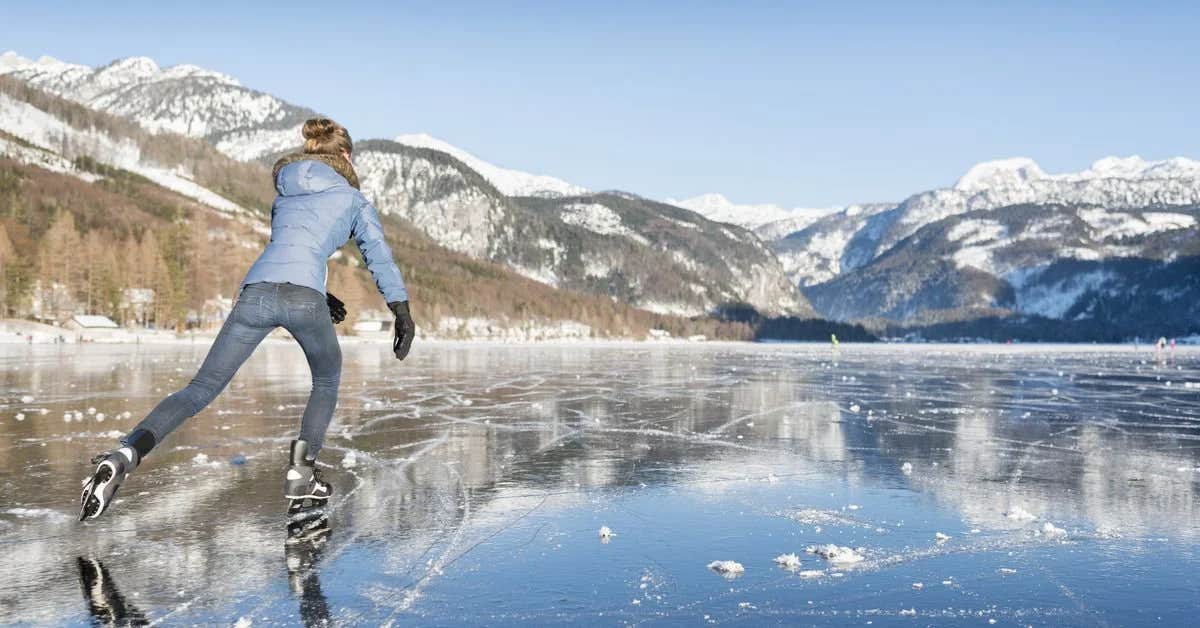Researchers finally solve the mystery of why ice is slippery
Sliding on ice is a familiar experience. Faraday hypothesized that ice forms spontaneously a thin quasi-liquid layer on its surface.

[Dec 19, 2022: María Milán, Universidad Complutense de Madrid]
Researchers conducted a computer simulation of how a solid slides over ice at the atomic scale, confirming the presence of a self-lubricating layer on the surface. (CREDIT: Creative Commons)
An international team led by the Complutense University of Madrid has conducted a computer simulation of how a solid slides over ice at the atomic scale, confirming the presence of a self-lubricating layer on the surface.
Sliding on ice is a familiar experience, but we still do not fully understand why is ice slippery. Faraday hypothesized that ice forms spontaneously a thin quasi-liquid layer on its surface, while Reynolds suggested that this layer could act as a lubricant. However, experimentally probing the structure of ice below a slider is extremely challenging.
The surface of the ice melts in contact with a solid, forming a lubricant layer which is self-perpetuating, as greater weight and slippage are applied to it. This cooperative phenomenon makes the ice more slippery and more likely to cause skating or car accidents, according to international research led by the Complutense University of Madrid (UCM).
In this study, published in Proceedings of the National Academy of Science, the researchers conducted a computer simulation of how a solid slides over the surface of the ice at the atomic scale.
Related Stories
"Our analysis of how the ice molecules are collectively organised to give them their peculiar lubricant power offers us a privileged insight into the process that could not be achieved through conventional experiments, given the huge difficulty in conducting an experimental observation of a lubricating layer of a thickness of a billionth of a metre", stresses Luis González MacDowell, a researcher at the UCM Physical Chemistry Department.
The slippery properties of ice have in some cases been exploited for leisure purposes (such as in ice-skating), and in others as a means of transport.
"It is important to understand the origin of this widely known property of ice, both in order to improve the performance of Olympic athletes, and to ensure vehicle safety during the winter," the expert indicates.
Aside from the UCM, the study also involves the Autonomous University of Madrid (UAM) and Marie Curie-Skłodowska University (MCSU) of Lublin, Poland.
Compatible hypotheses which pave the way for energy savings
Scientists have spent two centuries wondering why ice is slippery, and what causes the liquid layer which forms on top of it. Over the decades, figures including Michael Faraday, James Thomson, Osborne Reynolds and Philip Browden have come up with divergent hypotheses.
However, this study has served to demonstrate that they are in truth compatible, and operate simultaneously. "What we in fact find is that the key principles of the slippery nature of ice are the surface melting phenomenon proposed by Faraday; the gradual melting caused by pressure, reminiscent of Thomson's hypothesis, and the melting caused by friction, as proposed by Bowden", the UCM chemist points out.
This combination of factors gives the surface of the ice an exceptional self-repairing lubrication layer. "The problem with lubrication is that as the pressure increases, the lubricant is expelled from between the opposing faces, which leaves them in direct contact. In the case of ice, Le Chatelier's principle operates, and as the lubricating layer is driven away by the pressure, the ice itself melts and repairs the loss," indicates Lukasz Baran, the MCSU researcher who worked on the simulation technique during a six-month placement at the UCM.
Ice friction at the nanoscale. In a large temperature range between 230 and 266 K, hydrophobic sliders exhibit a premelting layer similar to that found at the ice/air interface. (CREDIT: PNAS)
Aside from preventing sporting and traffic accidents, the results of this study could be applied in designing better lubricants in other systems.
"It is important to remember that more than half the energy generated worldwide is lost through friction. Improved lubrication processes would mean a huge saving in fuel, money and environmental impact," concludes Pablo Llombart, researcher at the UAM's Nicolás Cabrera Institute.
Note: Materials provided above by the Universidad Complutense de Madrid. Content may be edited for style and length.
Like these kind of feel good stories? Get the Brighter Side of News' newsletter.
Joseph Shavit
Head Science News Writer | Communicating Innovation & Discovery
Based in Los Angeles, Joseph Shavit is an accomplished science journalist, head science news writer and co-founder at The Brighter Side of News, where he translates cutting-edge discoveries into compelling stories for a broad audience. With a strong background spanning science, business, product management, media leadership, and entrepreneurship, Joseph brings a unique perspective to science communication. His expertise allows him to uncover the intersection of technological advancements and market potential, shedding light on how groundbreaking research evolves into transformative products and industries.



